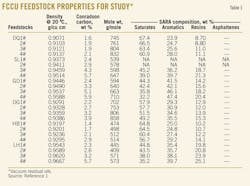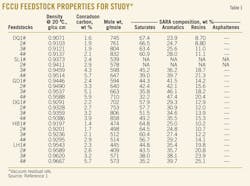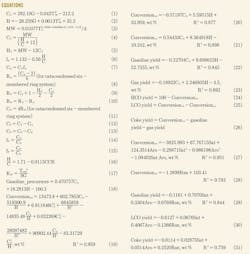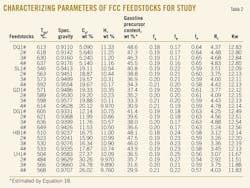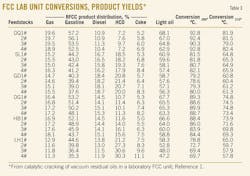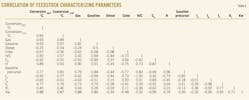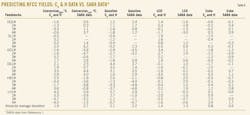D.S. Stratiev
I. Shishkova
R. Dinkov
Lukoil Neftohim Burgas
M. Mitkova
D. Yordanov
R. Nikolova
D.D. Stratiev
Burgas University
Burgas, Bulgaria
Earlier research found that residue fluid catalytic cracking (RFCC) product yields correlated with the content of saturates, aromatics, resins, and asphaltenes (SARA) fractions in RFCC feedstock.1 Performing a SARA analysis of residual oil, however, requires about 4 days: 2 days for deasphaltization and 2 days for separating the maltene fraction into saturates, aromatics, and resins by traditional elution chromatography.
This technique is unsuitable for daily monitoring of RFCC feedstock quality. A faster, simpler technique is needed to quantify RFCC unit feedstock daily. To meet this need, the authors have processed data generated by Xu et al. using empirical methods published in the open literature.2-4
We found that the empirical residue FCC feedstock characterizing parameters aromatic carbon and hydrogen content estimated by the ConocoPhillips correlations can be used to predict residual oil conversion and RFCC product yields. Moreover, the correlations developed in this work were found to be superior to those that predict conversion of the vacuum residual oils in the FCC process from the SARA analysis data.
The correlations developed allow quantitative characterization of residual oils feedstocks for RFCC units from only two easily available physical properties: specific gravity and molecular weight. These correlations can be used for daily monitoring of RFCC feed quality for optimization of RFCC unit performance.
Upgrading processes
During times of high crude oil prices, poorer quality of supplied crude oil and of oil reserves, low refining margins, and high differentials between prices of transportation fuels and heavy fuel oil, bottom-of-the-barrel (BOB) upgrading processes appear to be the savior of modern refining.5-8 The trend of decreased demand for heavy oil products also supports the leading role of BOB upgrading technologies in refining.9
Properly using the capabilities of BOB refinery units is vital to the competitiveness of any refinery. An increase of 0.7% conversion in a 25,000-b/d visbreaker unit is equal to $7 million/year.10 The RFCC, one of the BOB conversion processes, is an extension of conventional FCC technology developed during the early 1980s. It offers better selectivity to high gasoline and lower gas yield than hydroprocessing and thermal processes.
The RFCC process can be used to process residual oils whose Conradson carbon is no higher than 6%.11 12 The single variable with the largest effect on RFCC unit performance is feed quality.
An investigation showed that the yields of gasoline, light cycle oil (LCO), and coke correlated with the content of saturates, aromatics, and resins.1 Unfortunately Xu et al. have not investigated the relationship between conversion and RFCC feedstock quality characterized by the SARA analysis.
It is well known that reactivity of the RFCC feedstock is best described by the conversion achieved during its processing in the RFCC unit. The yields of gasoline, coke, and LCO depend not only on feedstock quality but also on catalyst selectivity and RFCC unit operating conditions.
It is also well known that the higher the reaction temperature, the lower gasoline selectivity.13 The lower the unit cell size of the zeolite in the FCC catalyst, the lower the hydrogen transfer activity and the lower the gasoline selectivity.14 Therefore the conversion achieved in the RFCC unit better indicates the reactivity of the feedstock and better describes the quality of the residual feedstock.
Another drawback of using the SARA method for quantitative characterization of the RFCC feedstock is how long it takes for execution: 2 days for deasphaltization and 2 days to separate the maltene fraction into saturates, aromatics, and resin fractions by traditional elution chromatography. The duration of SARA analysis makes this technique unsuitable for daily monitoring of the quality of RFCC feedstock.
Earlier research found that conversion of vacuum gas oils during processing in the FCC unit correlates with their content of saturate plus mononuclear aromatic hydrocarbons, called gasoline precursors.15-17 Stratiev et al showed that the gasoline precursor content in vacuum gas oils can be predicted by use of bulk properties of the vacuum gas oils and empirical correlations.18-20
Ding defined the content of LCO precursors as a sum of diaromatics+2-ring aromatic sulfur+1/2×3-ring aromatic sulfur.21
The SARA analysis data do not provide information about the content of gasoline precursor and LCO precursor because the aromatic fraction in the SARA analysis is not broken down into mono-, di-, and tri-aromatic hydrocarbons. Therefore the search for empirical methods that can relate the easily obtainable residue bulk properties with the conversion to products boiling lower than 350 °C. and conversion to products boiling lower than 210 °C. can be rationalized.
In this respect we have processed the data, generated in the work of Xu et al.1 by using empirical methods to characterize residual oils published in the open literature.2-4 22
The aim of this work is to develop new correlations capable of predicting RFCC conversion and yields from easily obtainable residual oil bulk properties and to compare them with the correlations developed by Xu et al., which are based on lengthy SARA analysis.
Experiment
Table 1 summarizes the physical and chemical properties of the RFCC feedstocks (vacuum residual oil fractions) used in this study. Based on these properties, their characterizing parameters have been estimated by the correlations described below:
1. Determination of aromatic carbon and hydrogen content by the ConocoPhillips (COP) method.2 This method can accurately predict the carbon aromatic and hydrogen contents of heavy petroleum fractions on the basis of routine analysis data—specific gravity and T50 (°F.; see nomenclature box).
Equations 1 and 2 (see equations box) estimate aromatic carbon and hydrogen content of the investigated residual oils.
2. Determination of molecular weight by the Goosens method,3 which requires density and distillation characteristics of residual oils. Equation 3 calculates the molecular weight of the studied residual oils.
This work applied the Goosens method to estimate T50 of the investigated vacuum residual oils by using molecular weight, determined by vapor pressure osmometry (VPO), and density, measured at 20 °C.
3. Determination of the average structural parameters of the residues. Based on the hydrogen/carbon ratio and average molecular weight, Equations 4-15 calculate the average structural parameters of the residues and their fractions.4
It was found that the H/C atomic ratio decreases linearly with an increase in Conradson carbon residue (CCR). Equation 16 provides the linear relation between CCR and H/C ratio. The correlation is based on 114 data points derived from 15 different crudes and has a correlation coefficient of R= 0.988.22
Equation 17 estimates the Kw factor of the residual oils.
Equations 1-16 estimate the investigated residual oils characterizing parameters (Table 2).
The RFCC experiments were performed in a laboratory-confined fluid bed reactor. The operating procedure of this laboratory's FCC simulation reactor unit has been described elsewhere.1 Table 3 summarizes the conversions and yields of the products: gas, gasoline (C5: 210 °C.), LCO (210: 350 °C.), heavy cycle oil (HCO; >350 °C.), and coke.
Conversion350 °C. is defined as 100 – HCO yield, wt %; Conversion210 °C. is defined as 100 – HCO yield – LCO yield, wt %.
Parameters CA, H
Equations 1-3 and data for molecular weight, determined by VPO and density measured at 20 °C., estimate the vacuum residual oils characterizing parameters aromatic carbon (CA) and hydrogen (H) content. Based on Conradson carbon and the molecular weight of the RFCC feedstocks, Equations 4-15 estimate the residual oil characterizing parameters fP, fN, fA (fractions of paraffinic, naphthenic, and aromatic carbon, respectively) and RT (average total ring number).
Table 4 presents data on the correlation matrix of the RFCC feedstock's characterizing parameters and the conversions and product yields. The data in Table 4 show that the conversion to products boiling at lower than 350 °C. correlates best with vacuum residue characterizing parameters CA and H content and Kw factor.
The residual oil characterizing parameters fP, fN, fA do not correlate with the RFCC feedstock conversion. It could be concluded from this that molecular weight and density and, based on them, estimated CA and H content are better indicators of the RFCC feedstock reactivity than molecular weight and Conradson carbon and calculated on their base characterizing parameters fP, fN, fA.
It should be also noted here that the gasoline precursor level estimated by the use of a correlation developed on the basis of data for vacuum gas oils is unsuitable for characterizing vacuum residual oils because it under predicts the content of saturates plus mononuclear aromatic content in the vacuum residues.20
One can see that the saturates content in the investigated vacuum residual oils (Table 1) is higher than the gasoline precursor level (Table 2), estimated by Equation 18.20 Therefore, the correlation that predicts the content of saturate plus mononuclear aromatic hydrocarbons in vacuum gas oils cannot be used to predict their content in vacuum residues.
The multiple regression Equations 19 and 20 predict conversion from CA and H content.
Equation 19 better predicts the Conversion350 of this data set. Its average relative absolute deviation is 1.06%, while that of Equation 20 is 1.86%. Nevertheless Equation 20 better reflects the chemistry of the process RFCC.
As can be seen from the data in the correlation matrix (Table 4) of the RFCC feedstock characterizing parameters, the increase of the CA content in the RFCC feed is logically associated with a decrease of its conversion. On the other hand, the increase of H content of the RFCC feedstock is logically associated with an increase of its conversion.
If a mathematical experiment with Equation 19 is made, one can see that the increase of H content at fixed CA content leads to an illogical decrease of the RFCC conversion. Therefore regardless of Equation 19's better accuracy for predicting Conversion350 for residual oils in RFCC, Equation 20 is preferred because of its better physico-chemical foundation.
Equation 21 predicts Conversion210. As in the case of Conversion350 (Equation 20), Conversion210 grows with a decrease of CA content and an increase of H content of the residual oil.
Equation 22 predicts the gasoline yield. The increase of H content and the decrease of CA content lead to a logical increase of gasoline yield.
Equation 23 predicts the gas yield; Equations 23-25 predict the yields of HCO, LCO, and coke.
Equations 19-26 indicate that conversions and product yields of the RFCC process can be predicted on the basis of molecular weight and density of the residual oil and by use of appropriate correlations. The Goosens correlation for molecular weight is used to estimate T50 from molecular weight and density data. Then data for T50 and density are employed to calculate CA and H content by the Conoco-Phillips correlations.
Table 5 presents data for correlation matrix of saturates, aromatics, and resins fraction and the conversion and product yields obtained during RFCC of the investigated vacuum residual oils. These data indicate that conversion of the residual FCC feedstocks decreases with the increase of aromatic and resin fractions content in the residues. This finding is in line with the observation made during catalytic cracking of vacuum gas oils, indicating that the aromatic and polar fractions retard catalytic cracking of the feedstock.23
Therefore the increase in the content of the aromatic constituents leads to a reduction of the RFCC feedstock reactivity. It should be noted here that both aromatic and resin fractions are in general aromatic fractions. The resin fraction contains higher levels of polar aromatic compounds and higher levels of polynuclear aromatic hydrocarbons than the aromatic fraction.2 24
Using multiple regressions, Equations 27 and 28 predict conversion from these residual oil characterizing parameters.
Equation 27 better predicts Conversion350 of this data set. Its average relative absolute deviation is 1.33%, while that of Equation 28 is 2.70%. Nevertheless, Equation 28 better reflects the chemistry of the RFCC process. As can be seen from the data in the correlation matrix (Table 5) of the RFCC feedstock SARA analysis data, the increase of the saturate content in the RFCC feed is logically associated with an increase of its conversion.
On the other hand, the increase of aromatics and resins content of the RFCC feedstock is logically associated with a decrease of its conversion. If a mathematical experiment with Equation 27 is made, one can see that the increase of aromatics and resins (100% saturates-aromatics) content is illogically associated with an increase of conversion.
Therefore, regardless of Equation 27's better accuracy for predicting Conversion350 for residual oils in RFCC from SARA data, Equation 28 is preferred because of its better physico-chemical foundation.
It should be noted here that the accuracy of predicting Conversion350 from the empirically determined residual FCC feedstock parameters CA and H content is superior to the prediction of Conversion350 from the SARA analysis data. Therefore the faster analysis of molecular weight and density (specific gravity) of the residual oils and the correlations developed in this work give more precise information about crackability of the residue in the FCC process than the lengthy SARA analysis.
Equation 21 could be considered an empirical estimation of the gasoline precursor level in vacuum residues, while Equation 20 could be considered an empirical estimation of the sum of gasoline and LCO precursor level in the vacuum residual oils.
Equations 29-31 give the correlations between SARA analysis data and the yields of gasoline, LCO, and coke developed by Xu et al.1
Table 6 compares the prediction capabilities of the empirical correlations developed in this work (based on CA and H content in the RFCC feedstocks) with those generated by the work of Xu et al., which are based on SARA analysis data. It is evident from these data that the yields predicted from information about CA and H content in the RFCC feedstocks are equivalent to those predicted from information about the level of saturates, aromatics, and resins.
The CA and H content, however, estimated from the ConocoPhillips correlations from data of molecular weight and density of the residual oil can be obtained within 2 hr instead of 4 days required for the SARA analysis. It should also be pointed out that the reactivity of a residual oil used as a feedstock for the FCC process, expressed by its conversion, is much better predicted by the use of the residual oil CA and H content than by saturates, aromatics, and resins content.
References
1. Xu C., Gao J., Zhao S., and Lin S., "Correlation between feedstock SARA components and FCC product yields," Fuel, Vol. 84 (2005), pp. 669–674.
2. Choudhary, T.V., and Meier, P.F., "Characterization of heavy petroleum feedstocks," Fuel Processing Technology, Vol. 89 (2008), pp. 697-703.
3. Goossens A.G., "Prediction of Molecular Weight of Petroleum Fractions," Ind. Eng. Chem. Res. Vol. 35 (1996), pp. 985-993.
4. Asphaltenes and Asphalts, Vol. 2, Teh Fu Yen and George V. Chilingarian, eds., Amsterdam: Elsevier, 2000.
5. Petkov, K., Stratiev, D., "Long term prognosis of crude oil price variation," Petroleum & Coal, Vol. 50 (2008), pp. 62-68.
6. Hajji, A., Muller, H., and Koseoglu, O., "Molecular Details of Hydrocracking Feedstocks," Saudi Aramco Journal of Technology, Spring 2010.
7. Callaud V., "Refiners 2011 Outlook and forward," European Fuels Conference, Mar. 13-16, 2012, Paris.
8. Stratiev, D., and Petkov, K., "Residue upgrading–challenges and perspectives," Hydrocarbon Processing, September 2009, pp. 93-98.
9. Muller, I., "Impact of EU policies on fuel demand dynamics," European Fuels Conference, Mar. 13-16, 2012, Paris.
10. Nedelchev, A., Stratiev, D., Stoilov, G., Dinkov, R., Lepidis, K., Sharpe, R., Russell, C.A., Petkova, N., and Petkov P., "Visbreaker performance improvement by optimisation of process conditions and application of chemical additive treatment program," 46th International Conference of Petroleum Processing, June 6-7, 2013, Bratislava.
11. Rana, M., Samano, V., Ancheyta, J., and Diaz, J., "A review of recent advances on process technologies for upgrading of heavy oils and residua," Fuel, Vol. 86 (2007), pp. 1216–1231.
12. Joshi, J., Pandit, A., Kataria, K., Kulkarni, R., Sawarkar, A., Tandon, D., Ram, Y., and Kumar, M., "Petroleum Residue Upgradation via Visbreaking: A Review," Ind. Eng. Chem. Res., Vol. 47 (2008), pp. 8960–8988.
13. Guide to Fluid Catalytic Cracking, Part 1, W.R. Grace & Co.—Conn., 1993.
14. Haas A., and Nee, J., "The role of zeolite and matrix activity in FCC catalysts on the molecular weight distribution of vacuum gas oil cracking products," Erdoel Erdgas Kohle, Heft 7/8, Juli/August, 1996, pp. 312-314.
15. Fisher, I.P., "Effect of Feedstock Variability on Catalytic Cracking Yields," Appl. Catal., Vol. 65 (1990), pp. 189-210.
16. Ng, S.H., Humphries, A., Fairbridge, C., Zhu, Y., Khulbe, C., Tsai, T., Ding, F., Charland, JP., and Yui, S., "Comparisons of FCC product yields and qualities between reactors using Canadian heavy feeds," Fuel Processing Technology, Vol. 86 (2005), pp. 1335–1385.
17. Yui, S., Matsumoto, N., and Sasaki, Y., "Athabasca oil sands produce quality FCC feeds," Oil & Gas Journal, Jan. 19, 1998, p. 43.
18. Stratiev, D., and Minkov, D., "Prediction of FCC Yields from Feedstock Quality Characterised by Empirical Methods," Oil Gas European Magazine, Vol. 1 (2000), pp. 27-32.
19. Stratiev, D., Galkin, V., Shishkova, I., Minkov, D., and Stanulov, K., "Yield of the Vacuum Gasoil Catcracking Products," Chemistry and Technology of Fuels and Oils, Vol. 4 (2007), pp. 31-35.
20. Stratiev, D.S., Marinov, I.M., Shishkova, I.K., Dinkov, R.K., Stratiev, D.D., and Petkov, P.S., "Prediction of the content of saturate plus mono-nuclear aromatic hydrocarbons in vacuum gas oils from bulk properties and empirical correlations," 46th International Conference of Petroleum Processing, June 6-7, 2013, Bratislava.
21. Ding, F., Ng, S.H., Xu, C., and Yui S., "Reduction of light cycle oil in catalytic cracking of bitumen-derived crude HGOs through catalyst selection," Fuel Processing Technology, Vol. 88 (2007), pp. 833–878.
22. Altgelt, K.H., and Boduszynski, M.M., Composition and Analysis of Heavy Petroleum Fractions, New York: Marcel Dekker, 1994.
23. Harding, R.H., Zhao, X., Qian, K., Rajagopalan, K., and Cheng, W., "Fluid Catalytic Cracking Selectivities of Gas Oil Boiling Point and Hydrocarbon Fractions," Ind. Eng. Chem. Res., Vol. 35 (1996), pp. 2561-2569
24. Andersen, S.I., and Speight, J.G., "Petroleum resins: separation, character, and role in petroleum," Petroleum Science and Technology, Vol. 19 (2001), Nos. 1-2, pp. 1–34
The authors
Dicho Stratiev ([email protected]) is chief process engineer in Lukoil Neftohim Burgas, Bulgaria. He joined the company in 1990 as a process engineer in the catalysis laboratory in the Research Institute for Oil Refining and Petrochemistry in Lukoil Neftochim. During his 22 years with the company, he has held several positions as process engineer on the visbreaker, vacuum distillation, and fluid catalytic cracking units. Since 2002, he has been deputy director of the institute. In 2004, he was appointed R&D manager in the company and in 2010 chief process engineer. Stratiev holds an MS in organic chemistry engineering and a PhD and DSc in petroleum refining from the Burgas University "Assen Zlatarov."
Ivelina Shishkova ([email protected]) is R&D department manager in Lukoil Neftohim Burgas, which she joined in 2002 as a process engineer in the catalysis laboratory in the Research Institute for Oil Refining and Petrochemistry. In 2003, she was appointed a research associate in the laboratory and in April 2010 attained her current position. Shishkova holds an MS in organic chemistry engineering and PhD in petroleum refining from the Sofia Chemical and Technological and Metallurgical University.
Magdalena Mitkova ([email protected]) is an associate professor and vice-rector of the Burgas University "Assen Zlatarov." She teaches in the organic chemistry technologies department in organic synthesis. Mitkova holds an MS and PhD in organic chemistry engineering from the Burgas University "Assen Zlatarov."
Rosen Dinkov ([email protected]) is the quality manager in the chief process engineering department of Lukoil Neftohim Burgas. He holds an MS in organic chemistry engineering from the Burgas University "Assen Zlatarov" and a PhD in technology of fossil and synthetic fuels from University of Chemical Technology and Metallurgy, Sofia, Bulgaria.
Dobromir Yordanov ([email protected]) is an associate professor in the Burgas University "Assen Zlatarov" where he teaches in the industrial technologies and management department in the field of the technology of fossil and synthetic fuels and quality management. Yordanov holds an MS and PhD in the technology of fossil and synthetic fuels from the Burgas University "Assen Zlatarov."
Radoslava Nikolova ([email protected]) holds a bachelor of science and is a master of science student in the "Professor Dr Assen Zlatarov" University. She interned at Lukoil Neftohim Burgas refinery in the process engineering department.
Danail Dichev Stratiev ([email protected]) is a student in specialty industrial technologies and management at the Burgas University "Assen Zlatarov." He interned with Lukoil Neftohim Burgas refinery in the process engineering department.
